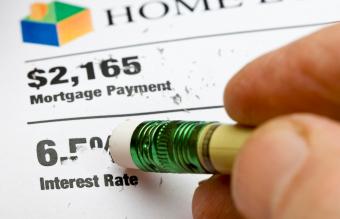
Without mortgage insurance, the dream of owning a home used to be out of reach for people who couldn't make the traditional down payment of 20 percent. But if you are willing to pay a little extra every month, the wait could be over.
What Is Mortgage Insurance?
Mortgage insurance, also referred to as private mortgage insurance (PMI), protects the mortgage lender in the event that a homebuyer can't keep up with his monthly payments. Most lenders prefer buyers put at least 20 percent down on a house. If the buyer can't make that much of a payment, the lender is assuming a greater risk of losing their investment. By obtaining private insurance, the buyer pays a monthly fee toward guaranteeing the lender's investment. If the buyer defaults on their mortgage, the lender receives the payout from the insurance.
For example, let's say you want to purchase a home for $140,000. Typically, your lender would like you to put down 20 percent, or $28,000, but you only have $7,000, or 5 percent. You would then mortgage the remaining part of the house cost, $133,000. Typically, PMI is 0.5 percent of your loan, making your mortgage insurance payment $665 a year. Mortgage insurance is paid monthly with your mortgage payment, so you'd see an increase $55.42 in your monthly mortgage payments to cover the mortgage insurance costs.
The good news is that this extra payment doesn't last forever. After you've paid off your mortgage to a certain amount, or your home appreciates, you can have your PMI cancelled.
History of Mortgage Insurance
This type of insurance has been around for years, but it wasn't until the Homeowner's Protection Act of 1998 that rules were in place to protect potential homeowners from being taken advantage of. Prior to the act, homeowners weren't informed about the options on their insurance policy, most notably regarding cancellation. Because of this, mortgage insurance was still being collected on houses even after the homeowner had paid over 20 percent of the mortgage price.
The Act now requires insurance companies to send a letter to policyholders once a year detailing the terms of the insurance and steps on how it can be canceled. Guidelines have also been established requiring companies to automatically cancel the policy after criteria have been met regarding the financial terms of the mortgage.
Cancelling Your Insurance
There are several factors that lead to the cancellation your mortgage insurance:
- Paying Down the Principal: You can request to have your policy cancelled once you've paid 20 percent of the mortgage. On the $140,000 home, that occurs when you've paid off $28,000. But remember, that only counts the principal of the loan, not the interest. In some cases, this could take ten years or more, unless you apply extra money to the principal each month.
- Home Appreciation: If your home has appreciated quickly, or if you've made improvements on the home that have increased its value, you might reach the 20 percent quickly. You can request an appraisal of your home to see if you've met the requirement. If you've been making payments on your house for several years and the house appreciated by 10 percent, making it worth $154,000, you might be close to saying goodbye to PMI.
- Automatic Termination: Once you've paid off 22 percent of your mortgage or your home has appreciated significantly, your insurance provider will automatically stop requiring payments. This means you'll need to have $30,800 of equity in your home. The insurance provider is required by law to make this change whether you've requested it or not.
If you've missed mortgage payments or are chronically late, you may have to pay PMI any longer. Also, many companies require you to pay for at least two years, so if you put in a marble floor or add a third floor to raise the home's value, you won't get out of the mortgage insurance at least during the first two years.
Piggyback Loans
Some brokers may advise you to take out a piggyback loan instead of insurance. A piggback loan is also called an 80-10-10. In a 80-10-10, the homebuyer puts down 10 percent for the house, gets a first mortgage for 80 percent of the home's value, and then gets a small second mortgage for the remaining 10 percent at a slightly higher interest rate. You'll have to do some number crunching to determine if this is a financially better answer than paying PMI. Keep in mind, you can deduct the interest on the second mortgage, something you can't do with the insurance payment, but you cannot pay the second mortgage off early by increasing your home's value. These smaller mortgages often have a large balloon payment at the end, which could be difficult to plan for in the future.







